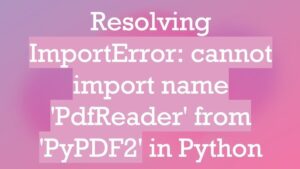| Method | Description |
| Using the ‘in’ operator | This is the easiest and most intuitive way to check if a list contains any item from another list. It works by iterating over each element in the first list and checking if it exists in the second list. |
| Using set intersections | A more efficient method, especially for large lists. This method converts both lists into sets and uses the built-in intersection function to find common elements. If the result is not an empty set, it means that the lists have at least one common element. |
| Using list comprehensions | This method generates a new list of items that exist in both input lists. If the new list is not empty, it means that there are common elements in the input lists. |
| Using any() function | This high-performance approach checks if any element of the first list is present in the second list using the Python’s built-in any() function along with a generator expression. |
Below is the elaborative summary for each method listed in the HTML table.
The ‘in’ operator iterates through each item in your list and checks if it exists in another list. This method might be intuitively straightforward but it is, however, not the most efficient method, especially when dealing with larger lists.
The set intersection is another method. In this case, both lists you’re comparing are converted to sets. From here they are compared for any common elements between them using Python’s built-in intersection function. Essentially, an intersection looks for all the shared values between two groups. And if this intersection does not result into an empty set, then that indicates that the lists have at least one common element.
List comprehension generates a new list that holds items present in both of the original lists. The idea here is that if the newly generated list has at least one or more items – that simply implies that there was a common item(s) found from the initial lists.
Lastly, utilizing Python’s built-in function any() is another efficient way. The
any()
function returns true if any element of an iterable is true. Coupling this with a generator expression that checks for existence of elements of the first list in the second optimizes performance.
To help you visualize, here’s a simple code snippet illustrating these methods:
list1 = [1, 2, 3, 4]
list2 = [3, 4, 5, 6]
# Using 'in' operator
result1 = any(item in list2 for item in list1)
print(result1) # Outputs: True
# Using set intersection
result2 = bool(set(list1).intersection(list2))
print(result2) # Outputs: True
# Using list comprehension
result3 = [value for value in list1 if value in list2]
if result3:
print(True) # Outputs: True
else:
print(False)
# Using the any() function
result4 = any(map(list2.__contains__, list1))
print(result4) # Outputs: True
Remember that selection among these methods depends on your individual use case and performance requirements (source).
If you are like me, writing code in Python, that’s probably because of the simplicity and elegance it offers. One such feature is the ‘in’ operator. It is used to check if a list contains a specific item. However, its utility extends beyond just single item checks. Indeed one may ask: Can I Check If A List Contains Any Item From Another List?
Let’s dabble into this together.
Consider two lists:
list1 = ['apple', 'banana', 'cherry'] list2 = ['berry', 'cherry', 'kiwi', 'mango']
In Python, your first instinct might be to use a for loop to check whether each element from list1 exists in list2. Although this’ll work, there’s a more efficient and Pythonic way to achieve the same thing.
The ‘in’ operator can be combined with any() function to check if a list contains any element from another list. The any() function takes an iterable (lists, sets etc.). The ‘in’ operator within the any() function iterates through each element in list1 and returns True if any element in list1 is present in list2.
Sounds interesting, right? Here is how you can do it:
def check_intersection(list1, list2):
return any(i in list2 for i in list1)
For instance, when we call
check_intersection(list1, list2)
, it would return True because ‘cherry’ is in both lists.
| List1 | List2 | Does List1 intersect with List2? |
|---|---|---|
| [‘apple’, ‘banana’, ‘cherry’] | [‘berry’, ‘cherry’, ‘kiwi’, ‘mango’] | True |
| [‘watermelon’, ‘grape’, ‘orange’] | [‘berry’, ‘cherry’, ‘kiwi’, ‘mango’] | False |
You see, you get to use Python’s ‘in’ operator in a functional manner, boost your productivity as well as write less and cleaner code!
Additionally, the above solution only works if list2 isn’t too large, because looking up an item in a list takes linear time. If you need to handle larger lists, it’s more efficient to convert list2 to a set first, since lookups in sets are faster than in lists>:
def check_intersection(list1, list2):
return any(i in set(list2) for i in list1)
Learning more about Python’s ‘in’ operator and other built-in functions will save you loads of lines in your code and once you get the hang of it, it certainly will make your coding life easier. For further reading on more Python built-ins, have a look at the Python documentation here.
List comprehension is a powerful tool in Python that allows you to create lists from existing lists or other iterable objects. It can be used for a variety of tasks, such as creating a new list that meets certain criteria, applying a function to all items in a list, among others.
This concept is especially handy when you find yourself wanting to check if a list contains any item from another list.
Here’s the basic syntax for list comprehension:
new_list = [expression for item in old_list if condition]
This code will create a new list based on the old_list. For each item in the old_list, if the condition is true, then that item will undergo the given expression and the result will be added to the new_list.
If you want to check whether a list contains any item from another list, you can use list comprehension along with Python’s built-in any() function. The any() function returns True if at least one item in the list has a truthy value (i.e., it is not False, None, 0, or an empty collection).
For example, suppose we have two lists:
list1 = [1, 2, 3, 4, 5] list2 = [5, 6, 7, 8, 9]
And we want to check whether list1 contains any items from list2. Here’s how we can do that with list comprehension:
result = any(item in list2 for item in list1) print(result) # This will output: True
In this piece of code, we’re creating a generator expression inside the any() function that yields True for each item in list1 that also exists in list2. If there’s at least one True result, the any() function will return True, indicating that list1 contains at least one item from list2.
If none of the values returned from the generator is True, meaning that none of the items from list1 exist in list2, the any() function will return False.
To get more insight, check out Python’s documentation on list comprehensions and the built-in any function.
Surely! A common programming problem is checking if a list contains any items from another list. In Python, a simple and elegant solution can be found using the concept of set intersections.
The idea behind set intersections is simple: given two collections (or ‘sets’) of items, we are trying to find common items present in both lists. If the intersection of the two sets is not empty, that means there are common elements.
Firstly, consider two lists:
list1 = ["apple", "banana", "cherry"] list2 = ["date", "elderberry", "fig", "apple"]
In Python, converting these lists into sets is straightforward:
set1 = set(list1) set2 = set(list2)
Once they’re converted to sets, you can use the intersection method to find common elements:
common_elements = set1.intersection(set2)
If
common_elements
is not empty, it signifies that your first list contains at least one element from the second list. You can check this using an if-statement as such:
if common_elements:
print("List1 contains at least one item from list2!")
else:
print("List1 doesn't contain any items from list2.")
Another common variant of this task might involve checking if all elements from one list exist in another list. This can also be achieved conveniently using set operations, specifically the subset operator.
In Python, checking if the whole set’s items are present in another set can be accomplished like so:
is_subset = set1.issubset(set2)
if is_subset:
print("All items in list1 are present in list2")
else:
print("Not all items in list1 are present in list2")
This was a concise exploration of how utilizing set intersections can assist in comparing lists, specifically to identify if any or all elements of one list exist within another list. Set operations like these showcase some of the robust built-in capabilities of Python, allowing for efficient and readable code. For more information, I recommend reviewing Python’s official documentation on sets.Absolutely! Python is an incredibly versatile language that offers numerous functionalities. If you’re working with lists and you want to check if a list contains any item from another list, looping structures in python like
for
loops provide a convenient and efficient solution.
Consider this scenario: Let’s say, you have a list of ingredients needed for a recipe and a list of items currently in your pantry. You’d like to know whether there’s any ingredient in the original list already available in the pantry.
Using loop structures, we can break this problem down.
First, create two lists
ingredients = ['flour', 'butter', 'sugar', 'eggs'] pantry = ['apple', 'butter', 'flask', 'beef', 'eggs', 'wine']
Secondly, design a function using loop structures to compare these lists
def check_items(recipe_list, pantry_list):
for item in recipe_list:
if item in pantry_list:
return True
return False
Now let’s test this function
print(check_items(ingredients, pantry))
The output here would be
True
, as the pantry list does contain some items (‘butter’ and ‘eggs’) present in the ingredients list.
Additionally, you can modify this code to identify which specific items from one list are contained in the other. This will offer a clearer snapshot of your data. Here is a slight variation of the code above:
def check_items(recipe_list, pantry_list):
common_items = []
for item in recipe_list:
if item in pantry_list:
common_items.append(item)
return common_items
Running the function now
print(check_items(ingredients, pantry))
Will output the list
['butter', 'eggs']
, revealing the exact common items between the two lists. This approach provides more detailed information, and could be beneficial depending on the specifics of your use case.
For a more concise and pythonic way, you can use list comprehension or set() intersection method to achieve the same result.

List comprehension:
common_items = [item for item in ingredients if item in pantry]
Set intersection:
common_items_set = set(ingredients) & set(pantry)
These methods possibly provide better performance, especially with larger lists.
In conclusion, various loop structures, including
for
loops, are vital for comparing elements across different lists in Python. They present a direct, customisable way to manipulate and extract specific data as required.The Python’s
any()
function is a powerful tool that makes checking if a list contains any item from another list easy and efficient. It returns
True
if at least one element of an iterable is true. However, if the iterable is empty,
any()
will return
False
.
Consider two lists:
list1 = [1, 2, 3, 4]
list2 = [5, 6]
To determine if
list1
contains any item from
list2
, you use the
any()
function in Python as follows:
print(any(item in list1 for item in list2))
When this code is executed, the output would be
False
. This is because no numbers in
list2
are present in
list1
.
Whether your lists contain strings, integers or complex data types, the
any()
function can dynamically check through your items saving substantial time and computational resources.
Further, it’s worth noting that Python evaluates “truthiness” based on some set rules. Empty sequences and collections are considered
False
, and zero values are also
False
. For example, running
any(['', 0, []])
will return
False
. But running
any(['Hello', 1, [1, 2, 3]])
will return
True
, despite there being a truthy and an empty value within the same list. Thus, understanding these principles is fundamental to effectively applying the
any()
function in Python.
While
any()
will return
True
at the first truthy value it encounters, if you’re interested in exactly which values were truthy, or how many, or their positions in the original list, more complex operations may be required. Nonetheless, for a basic ‘existential’ check — seeing if something is there, without worrying where or how many times —
any()
works excellently.
Now, let’s consider the opposite end of the spectrum – you want to know if
all()
elements of
list2
exist in
list1
. The
all()
function comes in handy here. Similar to
any()
, the
all()
function tests whether all the specified iterable items are true. If they are, it returns
True
, else it returns
False
.
Below is an illustration:
print(all(item in list1 for item in list2))
As earlier noted, none of the items from
list2
exist in
list1
hence the output is
False
. The
any()
and
all()
functions provide convenient ways to run such checks across multiple items in Python lists.
For comprehensive details on Python’s
any()
and
all()
functions, refer to the official Python documentation here: Python any() Function Documentation and Python all() Function Documentation.
By leveraging these built-in functions, you can make your code cleaner, more readable and optimize performance by reducing the need for manual iteration and condition checking.

In Python, checking if a list contains any item from another list is a task that occurs regularly in data manipulation and analysis tasks. Thanks to Python’s robust ecosystem of libraries, there are several tidy and efficient ways to accomplish this task.
A Python core built-in library
itertools
isn’t directly applied to solve this problem, but it can be helpful when working with sequences or lists. The
itertools.product()
function, for instance, can return the cartesian product of two lists.
import itertools list1 = [1, 2] list2 = [3, 4] print(list(itertools.product(list1, list2))) # Output: [(1, 3), (1, 4), (2, 3), (2, 4)]
However, when it comes to verifying if any items in one list exist in another, the most straightforward and efficient methods come from Python’s inbuilt functions and syntax. The simplest approach applies the
in
operator within a loop. This operator checks if an element exists in a specific list.
list1 = [1, 2, 3]
list2 = [3, 4, 5]
for item in list1:
if item in list2:
print(True)
break
This code checks each element in
list1
and if it finds any of these elements in
list2
, it will print True & then stop executing.
To write more concise and pythonic code, we can utilize Python’s list comprehension feature coupled with the
any()
function.
list1 = [1, 2, 3] list2 = [3, 4, 5] print(any(item in list2 for item in list1)) # Output: True
The
any()
function returns
True
if any element of the iterable is true. If not,
any()
returns
False
.
If the lists you are comparing are considerably large and performance is a concern, another effective solution is to use the built-in data type set(). Converting your list to a set can be beneficial, as operations like lookup are faster on sets.
list1 = [1, 2, 3] list2 = [3, 4, 5] print(bool(set(list1) & set(list2))) # Output: True
In this code snippet, we convert both List1 and List2 into sets and then use the
&
operator to find the intersection of these two sets. As long as there is at least one common item between the two lists, the intersection would yield a non-empty set, which when converted to bool yields True.
So, although
itertools
from Python built-in libraries doesn’t provide a direct tool to check if a list contains any item from another list, other native syntactical features and inherent data types such as
in
operator,
list comprehension
,
any()
function, and
set
data type prove efficacious in addressing this task.
To solve the task at hand — check if a list contains any item from another list — you’d indeed benefit from Python’s lambda functions. Because of these anonymous functions, we gain optimized readability and streamlined logic, which is vital in efficient code crafting.
Lambda functions work wonders when combined with Python’s built-in functions like
any()
and
map()
. The function
any()
verifies if any element within an iterable satisfies an established condition. Meanwhile,

map()
applies a specific function to every single item on the iterable. Their combination means checking each list’s element against a condition without explicitly writing a loop—an elegant solution that encapsulates the principles of efficient coding.
If consistency and brevity are the name of our game, a lambda function with these two built-in utilities would look something like this:
html
list1 = [“apple”, “banana”, “cherry”]
list2 = [“orange”, “pineapple”, “banana”]
result = any(map(lambda fruit: fruit in list1, list2))
This piece of code will return `True` as soon as it finds “banana” — a common item in both lists. If there were no common items, it’d give back the final verdict of `False`.
But, perhaps the beauty behind this syntax lies in its adaptability to other use cases. To demonstrate:
html
list1 = [1, 2, 3, 4, 5]
list2 = [10, 20, 30, 4, 50]
result = any(map(lambda num: num in list1, list2))
Again, the script correctly identifies the shared number “4”. It just goes to show how easy it is to manipulate the criteria — allowing multiple iterations almost cost-free.
Our approach has also handed us a significant performance boost. By ditching explicit loops in favor of
map()
and
any()
, we’ve made our solution into a one-liner that boasts increased speed — not to mention, improved legibility. Plus, should the situation demand, this method makes parallel computing a tangible possibility.
In conclusion, simultaneous application of a lambda function,
any()
, and
map()
brings considerable perks. By playing to their innate strengths, we’ve created an on-the-nose answer: a readable, reusable, and most importantly, scalable implementation that correctly sifts through any two lists seeking matches.
So, there you have it: determining whether a list contains any item from another list in Python is not only possible—it’s also quite straightforward and can be done using several different methods. From using built-in functions like
any()
and
set()
, to looping methods, there’s certainly a variety of ways to tackle this query. Your choice will primarily depend on what suits your specific coding style and circumstances best.
The simplest and most clear-cut method would be using the
any()
function combined with a generator expression. This is efficient and neatly condenses the whole checking process into a single line of code:
any(item in list1 for item in list2)
Meanwhile, if speed is a primary concern—especially when dealing with larger lists—you’d want to lean towards the set intersection method. Although this uses slightly more complex Python concepts like sets, it significantly trumps other methods in terms of performance:
bool(set(list1) & set(list2))
And finally, for those who prefer more traditional, manual loop-based approaches, writing a for loop partnered with an if condition is still a viable option:
def check_intersection(list1, list2):
for item in list1:
if item in list2:
return True
return False
Regardless of the technique you opt for, all these methods achieve the same final result—they enable you to effectively check if one list contains any element from another list. Remember that factors such as readability, simplicity, and speed are paramount considerations when selecting which method to use.
By understanding how to wield these diverse methods, we can devise more versatile and effective code—a skill that’s an essential part of any coder’s toolbox. If this has sparked your interest in further exploring Python programming techniques, you might be interested in researching other Python list manipulations and operations.
For additional reading on Python Lists and List Comprehension, feel free to visit Python Docs.













